Singapore is a vibrant country with a unique culture around food.
Dining out has long been a cherished tradition for many due to long working hours and as a form of enjoyment. Fast-paced lifestyles and high demand for efficient service have gained traction in the Singaporean food service industry. The rise of delivery services is making it an attractive market for operators.
The Singapore foodservice market size is estimated to be 24.88 billion USD in 2024 and is expected to reach 55.93 billion USD by 2029, growing at a CAGR of 17.58% during the forecast period (2024-2029).
The country’s trade and regulatory policies are focused on ensuring a consistent supply of safe, high-quality food and agricultural products.
For entrepreneurs and investors, the food service industry landscape is characterized by diverse culinary preferences and a strong emphasis on quality, innovation, and sustainability.
Overview of the Food Service Industry

The food service sector is characterized by diverse offerings, ranging from casual dining to specialized cuisines. It thrives on innovation, adapting to changing consumer preferences. Quality control and customer experience are essential.
The global foodservice market is forecasted to grow to 4.43 trillion U.S. dollars in 2028, showing a CAGR of 9.9 percent from 2021 to 2028.
Here are some critical functions of the food service industry:
- Food preparation: Involves the skilled creation and presentation of dishes.
- Customer service: Focuses on ensuring positive dining experiences through attentive and friendly service.
- Supply chain management: Encompasses sourcing, quality control, and logistics for ingredient procurement.
- Marketing and promotion: Drives customer awareness and engagement through strategic promotional efforts.
- Financial management: Involves budgeting, cost control, and profit optimization to ensure sustainable business operations.
The food service industry strives to meet modern consumers’ demand for convenient and diverse dining options. With fast-paced lifestyles, it provides quick, ready-to-eat solutions, while diverse culinary offerings cater to varying tastes.
Understanding the Singaporean Food Service Industry
The food service industry in Singapore was a $20.7 billion market in 2023 and is projected to grow at a 16.5% CAGR from 2024 to 2032.
From traditional hawker centers serving local delights to upscale restaurants offering international cuisines, the food service industry of Singapore is rich with options. Innovation, quality, and evolving consumer tastes drive the food service industry.
The food service industry in Singapore is highly competitive, with new restaurants and food concepts emerging regularly. It includes:
- Restaurants: Varied dining establishments offering diverse cuisines, from fine dining to casual eateries, catering to different preferences and budgets.
- Cafes: Popular for their relaxed ambiance, cafes serve coffee, light meals, and desserts, attracting people seeking a cozy environment for socializing or work.
- Bars: Establishments specializing in alcoholic beverages, ranging from cozy pubs to upscale cocktail bars, offering a social atmosphere for relaxation and enjoyment.
- Food Courts: Indoor dining spaces housing multiple food stalls offering various cuisines, providing convenient and affordable dining options.
- Catering Services: Providers of food and beverage solutions for events, parties, and gatherings, offering customized menus and professional services.
- Hawker Centers: Iconic open-air complexes hosting numerous affordable food stalls selling local delicacies and preserving Singapore’s culinary heritage.
During 2023, food caterers in Singapore recorded a 28.9% increase in sales compared to the previous year. However, the growth in revenue generated from takeaway transactions is forecast to be strong in most channels.
Segments of the Food Service Industry
The food service industry can be broadly categorized into two primary segments: commercial and noncommercial food service.
Commercial Food Service
Commercial food service operators include the for-profit sector of the food service industry. This segment includes:
- Restaurants
- Cafes
- Fast-food chains
- Commercial kitchens
- Fine dining establishments
- Food trucks
- Buffet-style restaurants
- Pizzerias
- Bakeries
- Breweries and brewpubs
- Casual dining restaurants
Customer-focused services are integral, as satisfaction drives repeat business. Personalized experiences, quality ingredients, and efficient service contribute to customer loyalty.
Their primary goal is profitability, and they compete for customers based on culinary innovation, ambiance, and service quality. Commercial operators often adapt to changing consumer preferences and market trends to remain competitive and maximize revenue.
Non-Commercial Food Service
Non-commercial operators are entities driven by a mission other than profit, such as schools, hospitals, government institutions, and corporate cafeterias. This segment includes:
- School cafeterias
- Hospital cafeterias
- Corporate cafeterias
- Government institutions
- Military mess halls
- College and University dining halls
- Senior living facilities
- Non-profit organizations
- Correctional facility cafeterias
- Daycare and childcare centers
They focus on providing food services as part of a broader mission, such as nourishing students or employees. Non-commercial operators prioritize nutrition, cost efficiency, and meeting specific dietary requirements within their unique institutional settings.
Importance of Food Service in the F&B Industry

The food service industry is essential to develop a link between food producers and consumers, facilitating the transformation of raw ingredients into palatable, ready-to-consume meals.
The food service sector in the F&B industry elevates dining experiences, providing various options from casual to fine dining. Food service’s importance lies in catering to diverse tastes, accommodating dietary preferences, and reflecting cultural nuances.
Moreover, the industry generates substantial employment opportunities and contributes significantly to the hospitality sector’s revenue.
Whether in commercial or non-commercial settings, the efficient functioning of food service ensures creativity, customer satisfaction, and the continuous evolution of trends, shaping the landscape of the food and beverage industry.
1. Facilitating Consumer Access
Unlike traditional home cooking, food service establishments such as restaurants, cafes, and food trucks provide a hassle-free solution for those seeking convenience.
From quick bites to cuisines, these establishments streamline obtaining diverse meals. With extended operating hours and a focus on efficiency, they cater to various lifestyles, accommodating busy schedules and diverse taste preferences.
This accessibility saves time and introduces consumers to different culinary experiences, developing a culture of exploration and experimentation.
2. Enhancing Dining Experiences
Food service establishments focus on ambiance, service quality, and a diverse menu. The ambiance of a dining establishment sets the tone, creating a memorable atmosphere that complements the culinary offerings.
Restaurant food service quality contributes significantly to customer satisfaction, with attentive and friendly staff enhancing the dining experience. The availability of a diverse menu caters to varied preferences, ensuring there’s something for everyone.
Whether it’s a cozy cafe, an upscale restaurant, or a trendy food truck, each food service setting delivers a unique and enjoyable environment.
Combining these factors transforms dining into a holistic experience, going beyond food and offering a sensory journey that engages and delights consumers.
3. Supporting Local Economies
Food service establishments generate employment opportunities across various roles, from chefs and waitstaff to managerial positions. The ripple effect extends to local suppliers, farmers, and artisans who provide ingredients, contributing to an ecosystem.
As these establishments grow, they promote economic growth by attracting tourism and creating a local scene. The revenue generated through food service activities further circulates within the community, supporting other businesses and services.
Beyond the financial aspects, food service provides a sense of community identity, as local flavors and culinary traditions are often celebrated.
4. Driving Innovation in Culinary Arts
Food service establishments promote culinary innovation, pushing the boundaries of taste and presentation. Chefs and food professionals within these establishments act as creative catalysts, experimenting with flavors, techniques, and global influences.
Whether in high-end restaurants or trendy food trucks, continuous improvement and innovation in food is the key to success. Customers can be satisfied through inventive menus and a commitment to service quality.
5. Creating Social Spaces
Food service establishments go beyond mere dining experiences, serving as meeting points where individuals connect, share, and celebrate.
With their relaxed ambiance, Cafes often encourage conversations and casual meetings, while restaurants become a place for family gatherings and celebrations.
The communal aspect of sharing meals in these settings enhances social bonds, contributing to the fabric of local communities. Whether through business meetings or friendly get-togethers, food service establishments are spaces where people come together for a shared experience.
6. Ensuring Food Safety and Compliance
From restaurants to food trucks, ensuring food safety, compliance, and hygiene is essential for preventing foodborne illnesses.
Compliance with regulations, including proper storage, handling, and preparation procedures, is essential. This commitment to safety protects consumers from health risks and builds trust and credibility for food service establishments.
By maintaining high standards and regulatory requirements, these establishments prioritize the well-being of their customers, contributing to a safer dining experience.
7. Catering to Specialized Markets
The food service sector is adaptable by catering to specialized markets and addressing diverse dietary restrictions and niche culinary preferences.
Whether accommodating gluten-free diets, vegan lifestyles, or unique taste profiles, establishments tailor menus to meet specific consumer needs. This flexibility broadens market reach and inclusivity, ensuring a broader customer base enjoys a satisfying dining experience.
Common Food Service Equipment
Here are some common food service equipment found in restaurants and commercial kitchens.
Commercial Refrigerators and Freezers
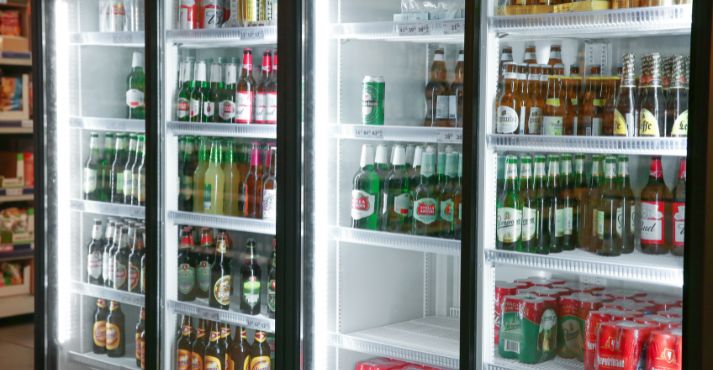
Refrigeration equipment is essential for keeping perishable food items fresh and safe for consumption in commercial kitchens. Following are some common units that maintain proper temperature levels to prevent food spoilage:
- Reach-in refrigerators and freezers
- Walk-in refrigerators and freezers
- Display refrigerators and freezers
Cooking Equipment

Various appliances are used to prepare and cook food in commercial kitchens. Below are some of the essential cooking equipment that allow chefs to create delicious dishes with precision and efficiency:
- Commercial ranges and ovens
- Griddles and grills
- Fryers (e.g., deep fryers, countertop fryers)
- Steamers (e.g., countertop steamers, steam kettles)
- Microwaves (commercial-grade)
Food Preparation Equipment
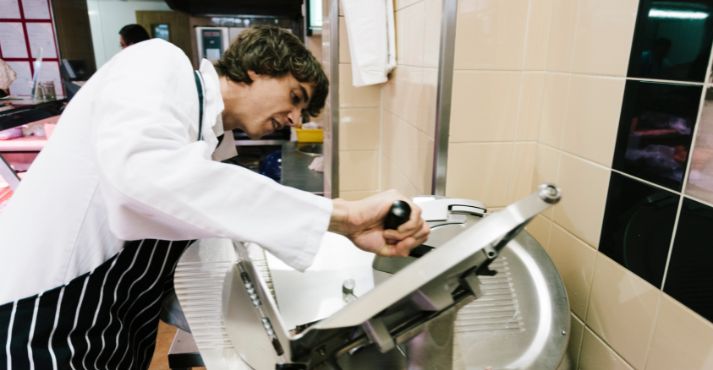
Food preparation equipment streamlines the process of chopping, slicing, mixing, and blending ingredients, saving time and ensuring consistency in recipes. Some indispensable tools for prepping ingredients quickly and efficiently include:
- Food processors
- Blenders
- Slicers (e.g., meat slicers, vegetable slicers)
- Food mixers (e.g., stand mixers, planetary mixers)
- Food scales
- Cutting boards and knives
Food Holding and Warming Equipment

Storage and holding equipment are essential for organizing and maintaining the freshness of food items in commercial kitchens. Some of them are:
- Food warmer cabinets
- Heat lamps
- Holding bins and drawers
- Heat shelves
- Soup warmers and kettles
Beverage Equipment
Beverage equipment includes a variety of machines and appliances used to prepare and serve beverages in restaurants, cafes, and bars. These tools ensure that customers receive their favorite drinks promptly and with consistent quality:
- Coffee makers (e.g., drip coffee makers, espresso machines)
- Tea brewers
- Beverage dispensers (e.g., juice dispensers, soda fountains)
- Bar equipment (e.g., blenders, cocktail shakers)
Cleaning and Sanitation Equipment
Hospitality sanitation equipment is vital for maintaining a clean and hygienic environment in commercial kitchens. The tools below help kitchen staff maintain cleanliness standards, prevent cross-contamination, and ensure food safety.
- Dishwashers (under-counter, conveyor)
- Sinks (three-compartment sinks, hand sinks)
- Warewashing racks and carts
- Cleaning supplies (mops, buckets, brushes)
Food Display and Merchandising Equipment
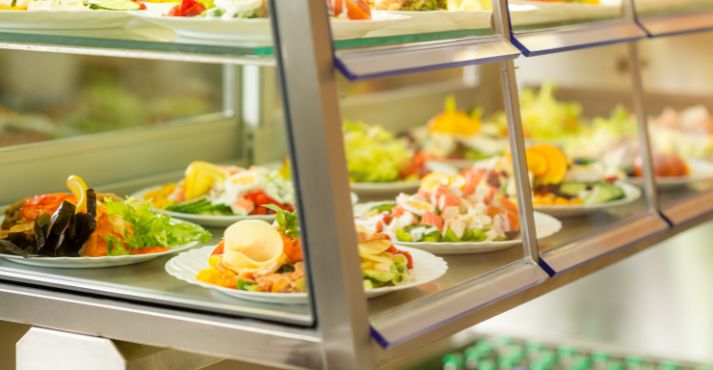
This type of equipment is designed to showcase food items attractively while keeping them fresh and easily accessible to customers. Some common units that enhance the presentation of food products and encourage impulse purchases in retail settings are mentioned below.
- Display cases (e.g., refrigerated display cases, bakery display cases)
- Merchandising refrigerators and freezers
- Hot food display units
Serving and Buffet Equipment
Serving equipment plays a crucial role in self-service and buffet-style dining establishments, allowing guests to serve themselves efficiently while maintaining food safety standards. Some common serving items are:
- Chafing dishes
- Serving utensils (e.g., serving spoons, tongs)
- Buffet warmers
- Beverage dispensers (e.g., coffee urns, beverage dispensers)
- Self-serve stations (e.g., salad bars, condiment stations)
Laws and Regulations in the Food Service Industry

Food safety laws and regulations are government-imposed standards to ensure food production, handling, and consumption are safe for human health. These regulations cover hygiene, sanitation, labeling, and quality control in the food service industry.
Compliance with these laws and regulations is mandatory for businesses to prevent contamination disease outbreaks, and protect consumers. Adherence to these regulations helps maintain the integrity of the food supply chain and safeguards public health.
Here are some of the critical laws and regulations to follow:
- Food Safety Modernization Act (FSMA)
Enacted to enhance food safety by shifting the focus from responding to contamination to preventing it. It mandates preventive controls, inspections, and compliance with safety standards, ensuring safer food handling.
- Occupational Safety and Health Act (OSHA)
Governs workplace safety, including food service establishments. It sets standards for employee safety, training, and handling hazardous materials to create a secure work environment.
- Health Department Regulations
Local health departments enforce regulations on food establishments, covering areas like sanitation, hygiene, and food handling practices. Compliance is crucial to prevent foodborne illnesses and maintain public health.
- Licensing and Permits
Food service businesses often require food service licenses and permits from local authorities. These ensure compliance with zoning regulations, fire safety codes, and other legal requirements, helping maintain a safe and lawful operation.
- Americans with Disabilities Act (ADA)
This federal law prohibits discrimination against individuals with disabilities. The food service industry ensures accessibility, reasonable accommodations, and equal opportunities for customers and employees with disabilities.
Trends in the Singaporean Food Service Industry
The Singaporean food service industry has witnessed healthy growth over the past few years. The sector has evolved across all its parts, from food preparation to packaging, home delivery, and fine dining restaurants.
As a result, trends that influence the Singaporean food service industry have continuously emerged and are expected to shape its future.
Explore the top 9 Singaporean food service industry trends regarding preferences, taste, packaging, technological advancements, and regulations.
1. Sustainable Dining
Achieving sustainability requires doing more together. Customers are now seeking restaurants that value sustainability in their operations as they grow more conscious of the impact of their food choices on the environment.
The growing emphasis on sustainability in the Singaporean food service industry reflects a shift towards responsible consumption, with companies increasingly adopting sustainable practices. It includes sourcing ingredients from local, organic, and ethically produced sources to reduce carbon footprint and support local communities.
According to the Economy SEA report, 23 percent of Singapore consumers considered sustainability a top criterion when purchasing packaged food.
Waste reduction initiatives such as composting, food waste recycling, and portion control are being implemented to minimize environmental impact. Moreover, food service establishments embrace eco-friendly packaging solutions like biodegradable containers and reusable utensils to reduce plastic waste.
For example, Greendot, Asian-fusion meat-free fast-casual concept to make healthy meat-free meals convenient, accessible, and affordable, started offering discounts to customers who bring their containers for takeout orders, encouraging reuse.
These initiatives align with consumer preferences for eco-conscious dining and contribute to building a more sustainable future for the industry.
The Greendot joined the Bring Your Own (BYO) Singapore movement, where 430 retail outlets offered incentives to customers who bring their reusable bags, bottles, or containers.

Source: Greendot
2. Plant-Based Menus
The rising popularity of plant-based and vegetarian dining options in Singapore reflects consumers’ growing awareness of health, environmental, and ethical concerns. More people are trying plant-based food and cutting down on their meat intake.
The Singapore Plant-Based Food and Beverage Market is projected to register a CAGR of 6.97% during the forecast period (2022 – 2027).
Market growth is attributed to high consumer awareness about the health benefits associated with plant-based food and beverages. Many are embracing plant-based diets for their purported health benefits and reduced environmental impact compared to traditional meat-based diets.
Singapore become the sixth most vegan-friendly city globally. Many local restaurants and hawkers have also begun adding plant-based options, leaving diners with a wide range.
For example, Whole Earth, a Singaporean plant-based restaurant, offers a menu using only the freshest ingredients, cooked and simmered with care. It offers the most innovative and flavourful vegetarian restaurant in Singapore.
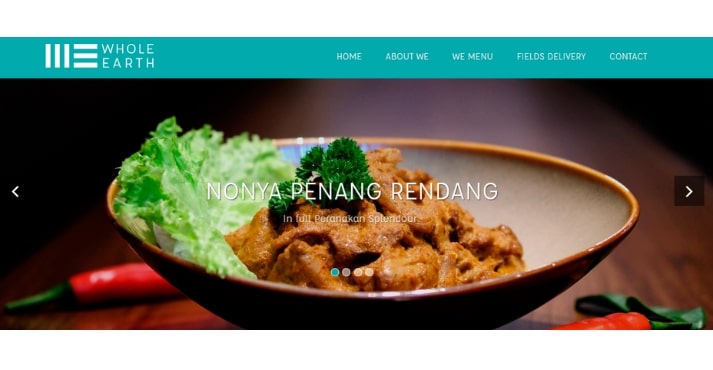
Source: Whole Earth
Embracing this shift, Singapore’s grab-and-go coffee chain Flash Coffee has partnered with local oat milk brand Oatside to make oat milk the default option in all its milk-based beverages across its outlets in Singapore.
Mintel Global Consumer research shows that 30% of Singaporean consumers limit their dairy intake, and 70% actively seek ways to be more environmentally conscious.

Source: Flash Coffee
3. Delivery-Only Concepts
The trend towards delivery-only concepts and virtual restaurants in Singapore has surged alongside the rise of online food delivery platforms and changing consumer behavior.
These establishments focus solely on preparing food for delivery, bypassing the need for physical dining spaces. These delivery-only cloud kitchens host multiple virtual restaurants under one roof, allowing for cost-efficient operations and increased consumer variety.
Orders are placed and paid for online, and then the restaurant fulfills the order by delivering it to the customer directly or through a third-party delivery company.
For example, Dabao Singapore has launched successful delivery-only concepts, leveraging technology and data insights to optimize their menus and delivery processes, catering to the growing demand for convenience and variety in dining options.

Source: Dabao Singapore
4. Fusion Cuisine
The globalization of Singapore’s food culture has also given rise to fusion cuisine. The trend reflects the different cultures in the region, blending diverse culinary influences and flavors to create unique and exciting dishes.
With a rich cultural influence of Chinese, Malay, Indian, and Western culinary traditions, Singaporean chefs skillfully blend ingredients and cooking techniques to craft innovative fusion creations.
Moreover, the influx of international travelers and tourists has played a vital role in introducing diverse culinary traditions to Singapore’s cuisine. It has enriched Singapore’s food culture and provided locals and visitors with culinary delights to explore and savor.
For example, Lerouy is a Michelin-star restaurant that offers a sophisticated fusion cuisine, which includes a French menu with an Asian flavor served at Christophe Lerouy’s name-brand restaurant. Lerouy serves an omakase menu that changes with the seasons.
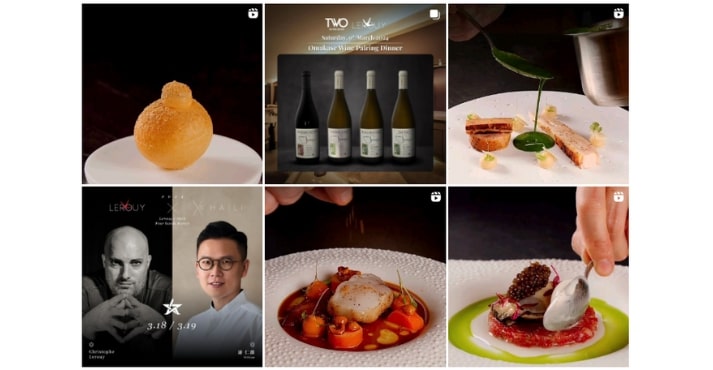
Source: Lerouy
5. Technology Integration
Restaurants and eateries are increasingly adopting technologies, allowing customers to conveniently browse menus and place orders from their smartphones or computers.
From contactless payment options to AI-powered menus and personalized recommendations, technology integrations provide dynamic and interactive experiences, enabling restaurants to update offerings in real time and showcase images and descriptions to customers.
Here’s how technology is enhancing the dining experience and improving operational efficiency in Singapore’s food service industry:
- Online Ordering Systems: Restaurants in Singapore leverage digital food ordering systems, offering convenience to customers and reducing wait times. These systems also enable efficient order management and integration with kitchen operations. According to Statista, 84% of Singaporean respondents stated that GrabFood was the food delivery app they used the most.
- Contactless Payment Options: With the rise of digital wallets and contactless payment methods, Singaporean eateries enhance customer safety and satisfaction. These systems expedite transactions, reduce queue times, and minimize the need for physical contact during payments.
- Digital Menus: Restaurants have digital menus, often accessible via QR codes, allowing customers to view dishes, prices, and specials on their smartphones.
Moreover, operational technologies like data analytics and customer relationship management software help food service establishments gain insights into consumer preferences and behavior, facilitating personalized service and targeted marketing efforts. It helps to improve the customer experience and can also increase repeat business.
6. Personalized Dining Experiences
The demand for personalized dining experiences is rising as consumers expect restaurants in Singapore to cater to their preferences.
Restaurants are responding by offering customizable menus and build-your-own-bowl concepts, allowing diners to select ingredients and flavors according to their tastes and dietary requirements.
These food service establishments focus on flexibility and choice, allowing customers to curate their dining experiences according to their unique preferences, whether they seek health-conscious options, specific flavor profiles, or cultural preferences.
For example, Aglio Olio offers a build-your-own-bowl concept with various fresh and healthy ingredients and provides personalized tasting menus tailored to each diner’s preferences and dietary restrictions.

Source: Aglio Olio
7. Immersive Dining Concepts
Immersive dining concepts merge food, art, music, and entertainment to create unique customer experiences.
Immersive dining experiences focus on engaging all five senses through visuals, music, aromas, flavors, and textures. Here are some of the different types of immersive dining experiences offered by the food service industry:
- Themed restaurants
- Multisensory dining
- Molecular gastronomy
- Dark Dining
- Immersive theoretical dining
- Pop-up events
- Destination dining
For example, LePetit Chef in Singapore offers a 3D Sensory experience to give a cinematic feel to the table. Even plates and cutlery become part of the vibrant landscapes presented, crafted with ingredients the chef collects on his journey.
The experience is whimsical and fun for ages from 1 to 100. It engages all senses with vibrant decor, lively music, and visually stunning food presentations, offering the diners a unique and memorable experience.

Source: Lepetit Chef
8. Health and Wellness Focus
Conscious consumers intend to spend more on products and services that improve their health, fitness, and nutrition. Singapore’s food service industry is experiencing a shift towards prioritizing health and wellness, reflecting a growing awareness of the importance of nutritious eating habits.
While unhealthy eating occurs in many different contexts, dining out is where individuals often choose an unhealthy option despite healthier alternatives.
However, the growing consciousness of health and wellness among consumers in Singapore has been driving rapid changes in the food business, emphasizing the need for balanced nutrition, organic options, and transparent labeling of dietary information.
For example, Haakon specializes in healthy food options, from vegan, paleo, gluten-free, high-protein, and low-carb appealing to health-conscious diners. Haakon’s Acai Superfood bowls for a real boost, and the ones containing zero-calorie shirataki noodles for all the satisfaction without the gains.
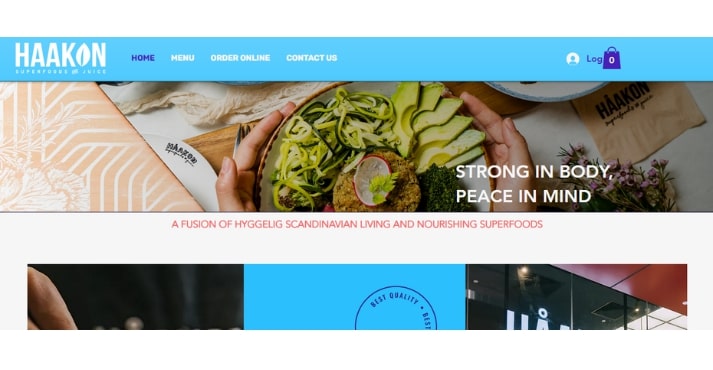
Source: Haakon
9. Creative Beverage Offerings
Singapore’s beverage industry is a fast-moving innovation center for non-alcoholic and alcoholic drinks. Consumers do not simply want to consume food and beverages but to experience them.
Health aspects and sustainability are also playing an increasingly important role. Consumers are demanding functional ingredients and natural, sustainably cultivated plant-based ingredients. Also, they are looking for added health value through natural vitamins or botanical extracts.
These trends shape the beverage industry by shifting demand from sugar-filled carbonated products to alternative health drinks. The suppliers are experiencing a surge in creativity, with bars, cafes, and beverage establishments showcasing creative beverages that captivate consumers with unique flavor profiles.
For example, The Kongsee bar is one of the most Instagram-worthy places that brings people together to relive and celebrate Singapore’s diverse cultural heritage.
The Father of Modern Singaporean cuisine, Chef-partner Willin Low, curated the nostalgic plates. The place offers an upbeat and vibrant vibe, with 15 taps of local craft beers and an extensive cocktail menu.

Source: The Kongsee
Distributors in the Food Service Sector
Distributors are the link between the manufacturers and the food service establishment. They facilitate the efficient flow of goods, ensuring the timely delivery of fresh and quality products to establishments.
Distributors manage inventory, handle logistics, and provide a link in the supply chain, contributing to the reliability and success of the food service industry.
Distributors in the food service sector perform essential functions within the supply chain, serving as intermediaries between producers and end-users. Some of these critical functions include:
- Logistics Management
Distributors coordinate transportation, storage, and delivery, ensuring a seamless flow of ingredients from producers to end-users and optimizing efficiency in the supply chain.
- Inventory Control
Distributors manage stock levels, preventing overstock or shortages. This precision enhances ingredient availability, providing a reliable and diverse selection for food service establishments.
- Order Fulfillment
Efficient processing and timely delivery of orders contribute to the consistent availability of ingredients, enabling businesses to maintain a varied and reliable menu for customers.
Food Service Industry (FAQs)
What is the most expensive cost in the food service industry?
The most expensive cost in the food service industry is the labor cost. Wages for chefs, kitchen staff, servers, and other personnel, combined with benefits and training expenses, significantly impact operational expenses.
Managing labor is essential for maintaining profitability while delivering quality service and products.
What is the most common guest complaint in the food service industry?
Service-related issues, such as slow or inattentive service, are among the most common guest complaints in the food service industry.
Poor customer service can overshadow even excellent food, so providing prompt and courteous service is critical to ensuring customer satisfaction and positive reviews.
What is the structure of the food service industry?
The food service industry includes restaurants, cafes, catering services, food trucks, and institutional dining. Each segment has distinct characteristics, target markets, and operational models.
The industry encompasses quick-service and full-service establishments, fine dining, and fast food, shaped by consumer preferences, trends, and the local culinary scene.
Conclusion
The food service industry is one of the largest industries in the world. From the bustling kitchens of fine dining establishments to the quick-paced world of food trucks, the food service industry caters to an array of consumer preferences and culinary experiences.
The increasing demand for food away from home can be attributed to the rising dining-out trend, growing fast food chains, and increasing demand for luxurious food, boosting the food service market growth.
The increasing presence of disruptive technologies, digitalization, and the chase of new holistic experiences are redefining the food service industry.













